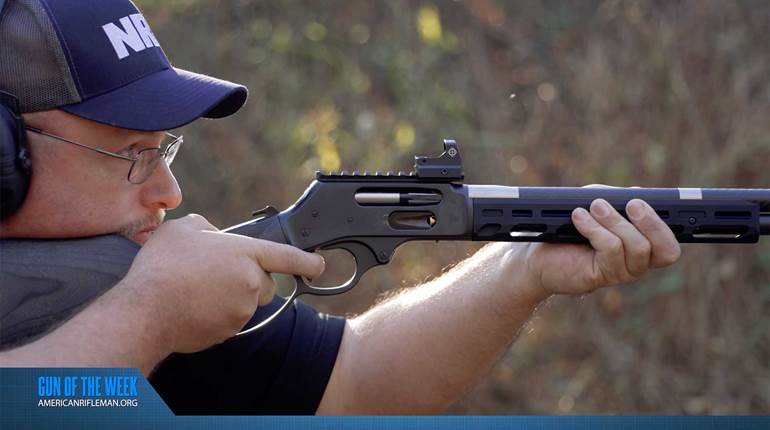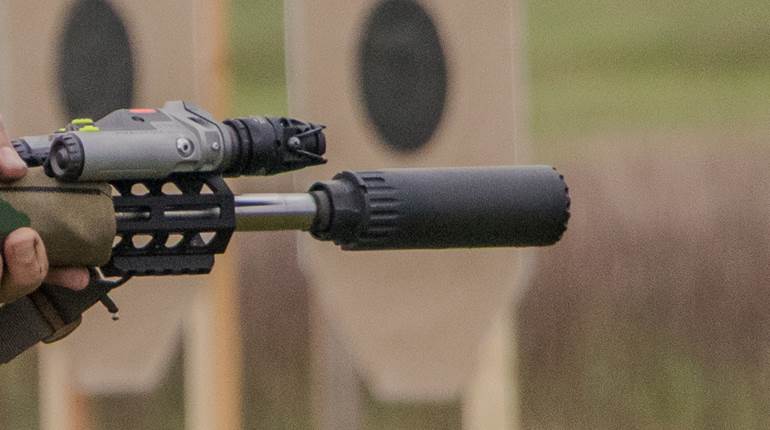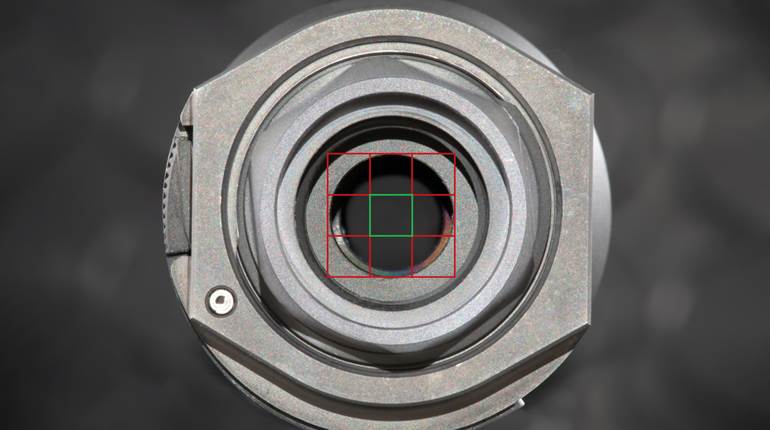
Top image courtesy KDMCans.com
If you ask just about any grey-haired shooter, “How’s your hearing?” you will likely get an answer of, “How’s that?” or “Say again?” often with one ear cocked toward you. Fact is, guns make a lot of noise, and that noise will damage your hearing, especially if you don’t wear adequate hearing protection—or “ear pro” in range lexicon. None of this is news; shooters have complained about noise for more than a century. 
Hiram Percy Maxim, son of Sir Hiram Stevens Maxim, who invented the Maxim machine gun, was a mechanical engineer out of the Massachusetts Institute of Technology (class of 1886). He had a passion for inventing and marketing. By 1902 he had a workable silencer and began selling them under his trademarked name, Maxim Silencer. Almost concurrently, he upsized his silencing device to quiet down automobiles. Seven years later he received a patent for his firearm silencing device.
Today’s silencers use pretty much the same technology as Maxim did. Modern silencers may use more exotic metals and alloys to deal with the intense heat and pressures generated by modern guns, but the principle of slowing down supersonic combustion gases and turning that energy into heat is the same as it was more than a century ago. So how exactly does a silencer work?
Let’s get some terminology straight first: Maxim’s original patent called the device a “silencer,” and as we shall see in a minute, these devices are very good at silencing the report of a firearm. But it cannot completely silence a high-velocity firearm where the bullet travels at speeds greater than the speed of sound. Many use the term “suppressor,” and insist it is the only correct term. The first use of the term “suppressor” was in a patent application (U.S. Patent 4530417, July 23, 1985, “A suppressor for reducing the muzzle blast of firearms or the like.”). I believe that those who cling with tenacity toward the term “suppressor” are more interested in softening the imagined nefarious impact of the term “silencer.” I figure the guy who invented the contraption knew what he wanted to call it, so I’m going with silencer.
When a firearm is discharged, burning powder generates a relatively high volume of combustion gases in a very short period of time. The bullet and the case confine those gases, consequently causing the internal pressure to rise very quickly. It is that pressure that pushes the bullet down the bore. As the bullet increases in speed, the combustion gases increase in speed as well. When the bullet exits the barrel, the rapidly moving combustion gases hit stagnant atmosphere gases, essentially slapping those gases. It is the impact of combustion gases to atmospheric gases that causes the report of a firearm—the “boom!”
A silencer is a device that slows down the speed of those combustion gases. The energy from those rapidly moving gases is transferred into heat energy. Therefore, when the bullet exits the barrel and silencer, the gases behind the bullet have been slowed to a point that it is more like a “puff” than a slap.
The silencer accomplishes this feat by a tube attached to the muzzle of the firearm. Inside the tube is a series of expansion chambers and baffles, sometimes including a “wipe” to corral the last bit of combustion gases. In the center there are holes in the baffles to allow the bullet to pass through without been touched or damaged by the baffles. The passing through of the bullet creates a bit of a vacuum, causing the expanding combustion gases to partially switch direction, thus slowing them down a little more. Because the bullet remains untouched as it passes through the silencer, it does not lose any of its initial velocity. In fact, with modern silencers, the clearance between the bullet and the baffles is so close that there remains a slight degree of push on the bullet with a silencer, thus providing a minute increase in muzzle velocity.
There are usually five to 15 baffles stacked in the tube, each providing a mini-expansion chamber to progressively slow down the combustion gases. On the attachment end of the silencer there is usually a relatively large expansion chamber to brake the gases before they pass through the baffles. The baffles are shaped to induce a swirling motion to the gases, thus increasing the vacuum phenomenon as the bullet continues on its path.
A common misunderstanding about silencers is that the device can completely erase any acoustic signature generated by the discharge of the firearm. The silencer only addresses the combustion gases generated during the firing. If the velocity of the bullet is greater than the speed of sound (1,125 fps at 68 degrees at sea level), there will be a supersonic crack or sonic boom generated by the bullet. This is the same “boom” generated by a jet traveling at greater than the speed of sound, except for scale. A 10,000 lb. jet is going to move much more air than a bullet weighing less than an ounce, consequently the “boom” of a supersonic jet is going to be more intense than that of a bullet. Therefore a silencer can do nothing to attenuate the sonic boom of a supersonic bullet. That said, a silencer is very efficient at quieting the report of a firearm. 
Silencers are attached to the muzzle of a firearm in several ways, the most common being direct thread (Blackhawk! Pulse Rimfire Sound Suppressor, right). The barrel is externally threaded at the muzzle for a short distance, and the silencer is correspondently threaded internally. It is a simple matter to screw the silencer—or “can” because they resemble a can, as silencers are commonly referred to—onto the muzzle end of the firearm. It is necessary to fully seat the can against the shoulder on the barrel of the firearm to ensure it is centered. Most of us who shoot with silencers put some form of thread lubricating or anti-seizing compound on the threads to keep them from galling.
Some silencers are made to fit over a flash suppressor, like those on the AR-style of rifles. My SureFire can requires a SureFire flash suppressor with an indexing notch set at 6 o’clock in order to center then can with the barrel. The can has an eccentric collar that twist-locks against a collar at the rear of the flash suppressor. A third type, usually seen on older silencers of dubious quality is a simple twist lock against a stud protruding from the barrel. These may look cool in a movie, but they won’t hold up to regular use very long.
There are some silencers designed to be run “wet” (Inland Mfg. PM-22 shown). This means that the user will pour some water, grease, foam or other liquid into the silencer before attaching it to the firearm. The liquid may have some attenuating qualities, but its real purpose is to keep the silencer cool during rapid fire. 

Rimfire silencers are usually capable of being torn down for maintenance. That’s because they operate at much lower pressures, and the powders used in rimfire ammunition tends to be pretty dirty—it leaves a lot of residue. Cans used on rimfires should be cleaned after no more than a hundred rounds. With my KDM rimfire can, I usually take it apart and soak the baffles in Kroil overnight and then put them thru my ultrasonic cleaner. If I have been slothful in my cleaning—like after a four-day prairie dog shoot where I don’t haul my ultrasonic cleaner along—it may take two or three soakings and some wire brushing to get the baffles clean.
Most center-fire silencers are welded shut. The pressures, heat and intensity make these cans self-cleaning. Still I check the threads on my “big” can every time I remove it and ensure no garbage has gotten into it. The threads on these things and the barrels are pretty fine and susceptible to damage, and that kind of damage is not easy to fix. 
At this point silencers remain under the 1934 NFA stranglehold. For each can, you will have to fill out a Form 4, get photographed and fingerprinted and have a background check by your local law enforcement agency. And, of course, you still must write a $200 check for the tax stamp that will be affixed to your Form 4 when it is returned to your Class 3 dealer. At that point—currently it's about a 4-month wait—you can retrieve your silencer from what is colloquially referred to as “ATF Purgatory.” I would recommend that you make a copy of your Form 4 with the stamp and keep it with you whenever you are out with your can in case the law wants to discuss the matter with you. Keep the original at home in your gun safe. There is legislation pending that would remove silencers from their NFA status and allow them to be purchased with a simple 4473 form like any other firearm, but the wheels of legislation turn at about half the speed of any other government agency. Right now the following states prohibit civilian suppressor possession: California, Delaware, Hawaii, Illinois, Massachusetts, New York, New Jersey, and Rhode Island.
It is almost funny how something as innocuous as a “muffler” for your firearm could acquire such a noxious pall over it after 84 years under government control. Hiram Maxim invented the silencer for folks who wished to target practice in their backyards in places like New York City—at that time target shooting was a popular pastime in the U.S. He likely never even considered its criminal use. Today, many of us submit to the onerous governmental circus and pay for the tax stamp in order to preserve our hearing. I, for one, have gone to nothing but silenced guns for my prairie dog shoots, where we often shoot some 300 to 400 rounds in a day, in order to preserve what little hearing I have left. Huh? Say what?
Additional Reading:
5 Reasons to Consider a Suppressor
The Real Scoop on Sound Suppression
Is It a Suppressor or a Silencer?
Sound Suppressors 101
Dr. Shush
10 Quietest States in the Union






































